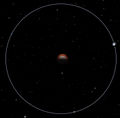Difference between revisions of "Duna"
Adam Green (talk | contribs) (→Orbital Statistics: Adding orbit definition link from wikipedia, and added - to semi-synchronous for consistency.) |
(add Duna_map_800.gif) |
||
| Line 81: | Line 81: | ||
File:Duna_projection.png|A false color Mercator projection of Duna's surface using MapSat. | File:Duna_projection.png|A false color Mercator projection of Duna's surface using MapSat. | ||
File:Duna_and_ike.jpg|Duna and Ike. | File:Duna_and_ike.jpg|Duna and Ike. | ||
| + | File:Duna_map_800.gif|A topografic height map of Duna made with the ISA MapSat plugin | ||
</gallery> | </gallery> | ||
Revision as of 19:57, 20 October 2012
Duna is the fourth planet of the Kerbol star system. It is the Mars analog for Kerbal Space Program and is mostly red with polar icecaps. It has one natural satellite, the moon Ike. Due to Ike's size and proximity, Ike and Duna are tidally locked to each other.
Contents
Topography
|
Duna is a iron-rich planet which has greatly varying land altitude, the consequence of which is very difficult judgment of a safe landing position. Its mountainous ranges are a peril to landing craft, especially considering the thin atmosphere, where very little aerobraking can be done safely. It is important to slow one's ship down before coming into the atmosphere, to ensure a safe descent. Its two poles are very expansive and are the result of a thin atmosphere. The lower regions make a shape resembling Europe. |
Atmosphere
|
Duna's atmosphere begins at 41,446 m. It is only 20% as dense as Kerbin's at altitude 0 and is even less dense (relative to Kerbin) at higher altitudes. Like the atmospheres of Eve and Kerbin, Duna's atmosphere fades exponentially with increasing altitude (with a scale height of 3000 m). In general, the atmospheric pressure on Duna at an altitude expressed in meters is:[1] Parachutes work at lower efficiency than on Kerbin, making powered descent necessary when landing from orbit (unless your craft is a glider or just a pod with a parachute). |
Orbital Statistics
The geosynchronous orbit of Duna is at an altitude of 0.00 m above Duna. The speed of the satellite is 0.00 m/s and it has an orbital period resonating with 1 Duna day (18.2 hours or 65517.859375 seconds).
For a semi-synchronous orbit of ½ Duna day (9.025 hours or 32490 seconds) an orbit of 0.00 m above Duna is needed with a velocity of 0.00 m/s.
Reference Frames
| Warp | 5x, 10x | 50x | 100x | 1000x | 10,000x | 100,000x |
| Minimum Altitude | above atmosphere | 60 km | 100 km | 300 km | 600 km | 800 km |
Gallery
- Duna projection.png
A false color Mercator projection of Duna's surface using MapSat.
Changes
- Initial Release
Notes
- ↑ A nuclear engine has a specific impulse of 220 in 1 atm, 800 in vacuum, and the following at various Duna altitudes:
altitude (m) 2 100 300 500 1460 2420 3000 4272 5000 10000 specific impulse 684.1 687.8 695.1 701.8 728.7 748.2 757.3 772.1 778.1 795.9






